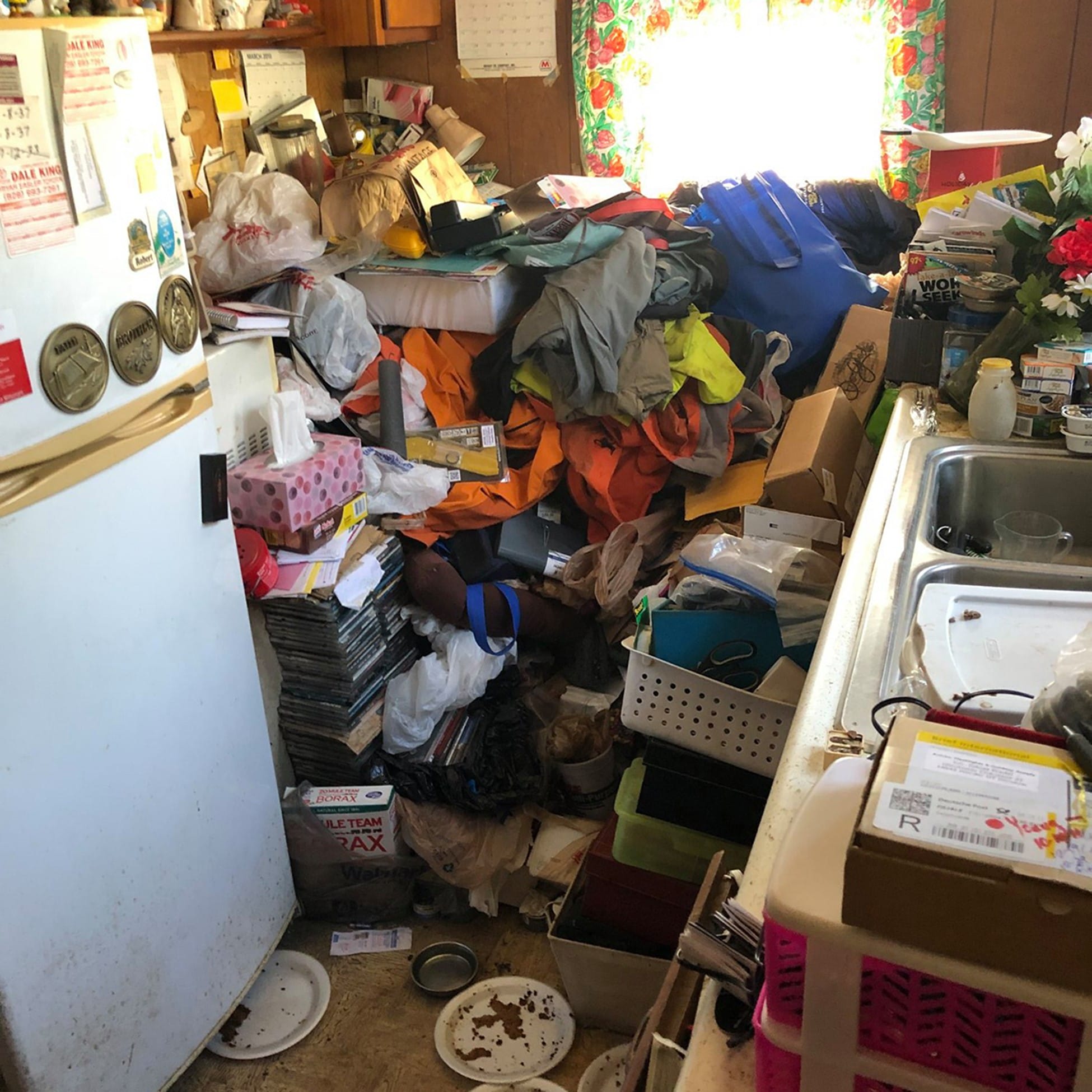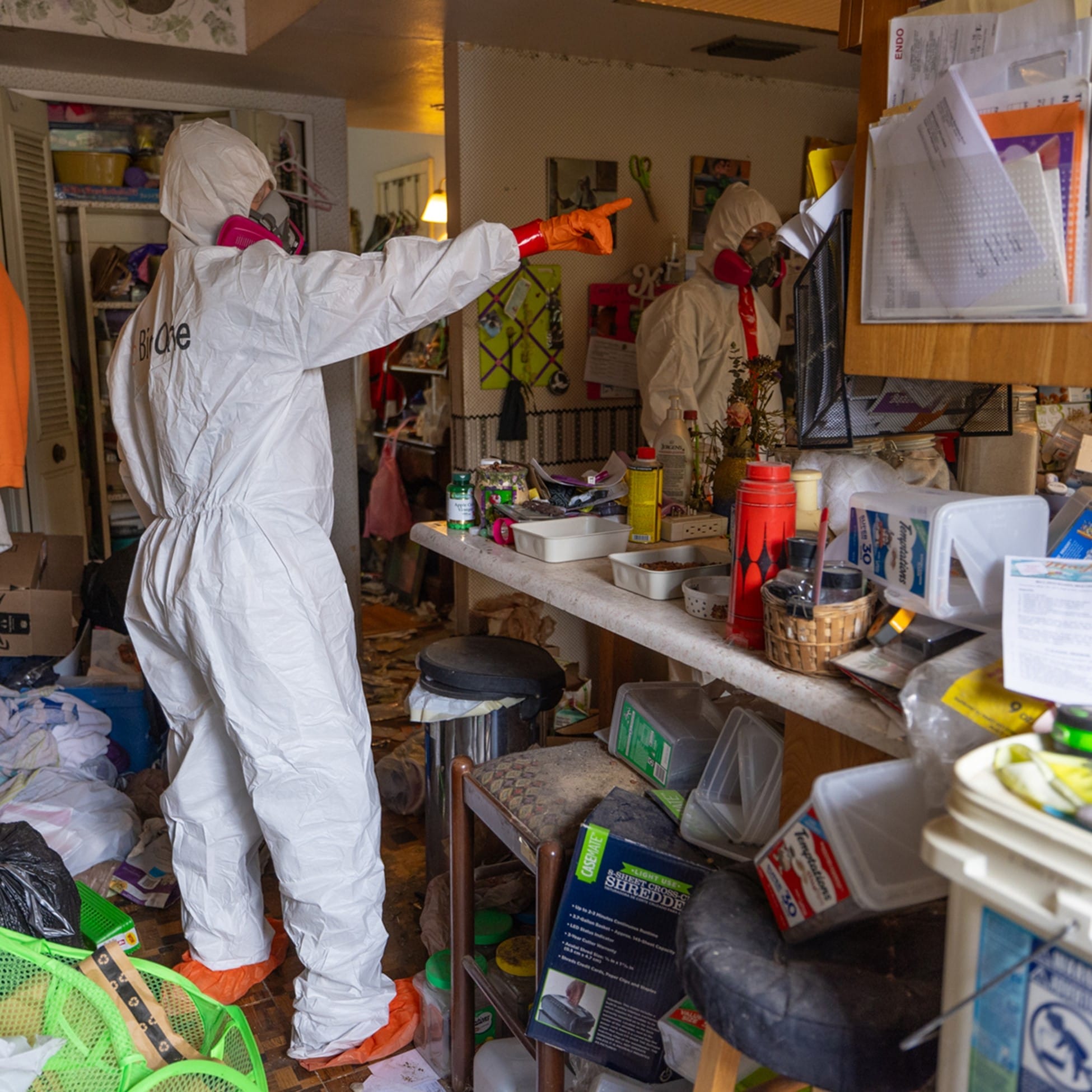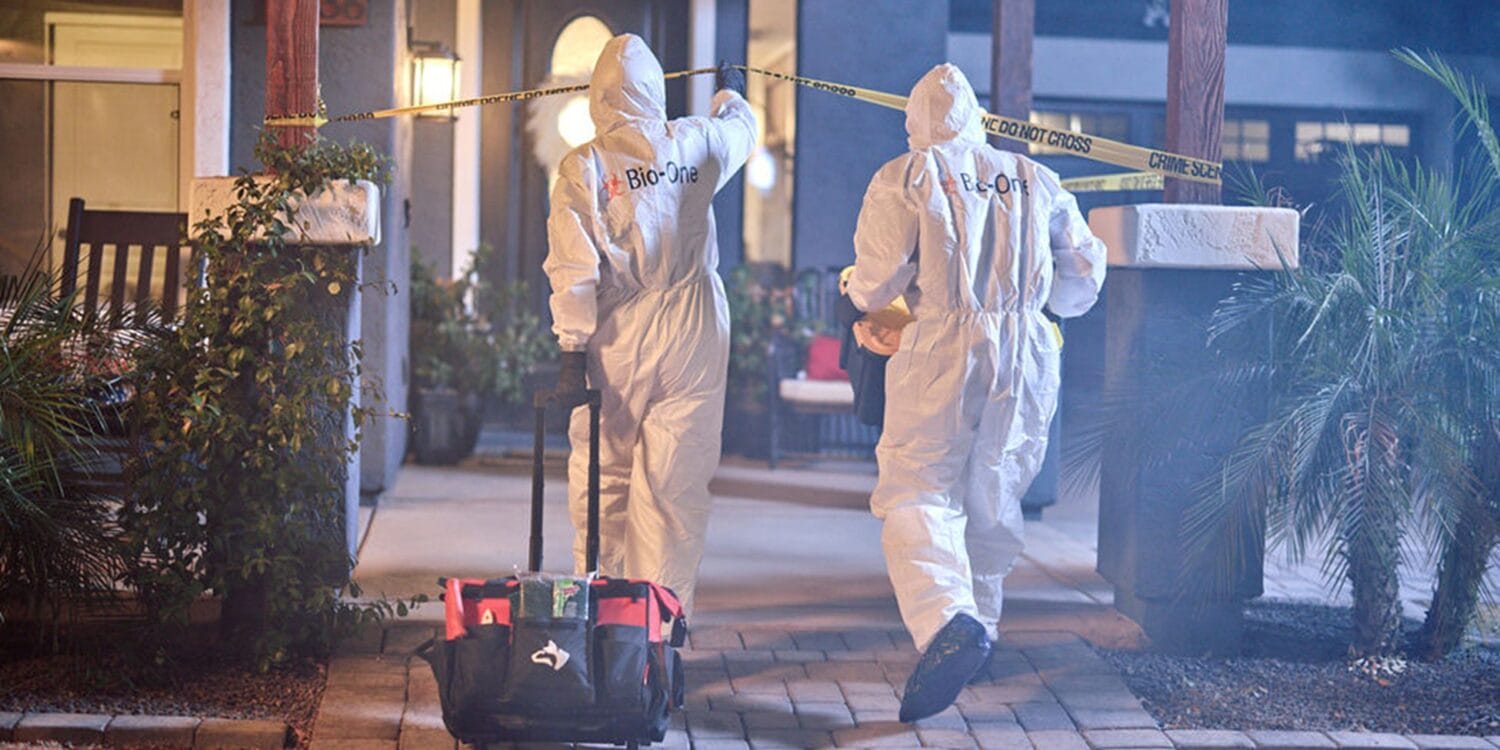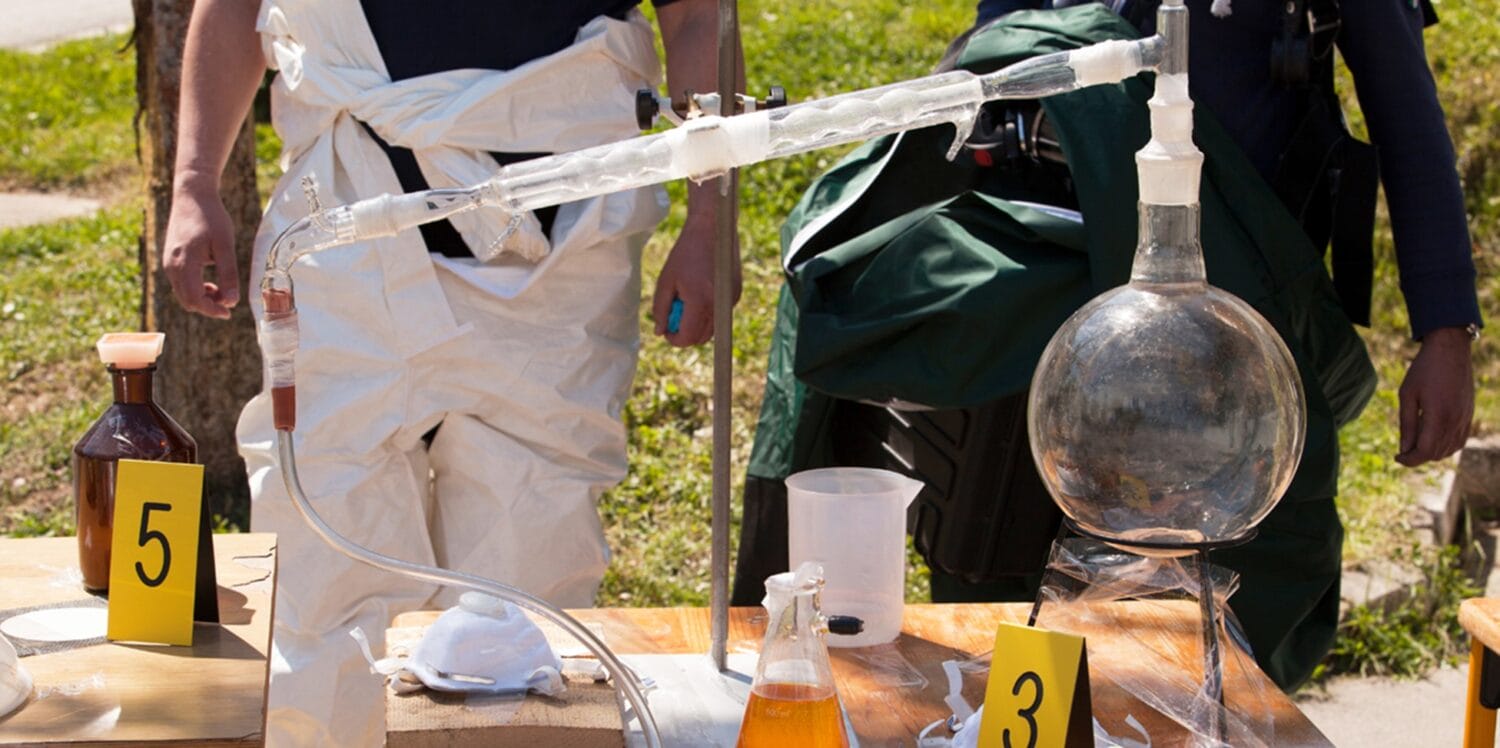Navigating Hoarding Disorder Together: Support Strategies for Families
At Bio-One of Augusta, we’re acquainted with the journey that brought you here. We understand you’ve already been trying to solve this problem alone—and we’re proud of you. It’s tough. You’ve been struggling out of concern for the hoarder, for you, for your family, for the property… and the list can go on.
Hoarding is complicated and messy. But you already know that.
After 20+ years of hoarding cleanup, we’ve made some observations and learned some lessons we’d like to share with you—because we feel they might help you and the hoarder.

On the outside looking in, you see clutter, chaos, and conditions that are unhealthy and hazardous, such as:

On the inside, however, you see a person—a family member—struggling and probably isn’t consciously choosing to live this way.
Hoarders hoard for various complex reasons, and the exact cause can vary from person to person. Hoarding is recognized as a mental health disorder known as "hoarding disorder."
It's essential to understand that hoarding is not just a matter of being messy or disorganized; it involves deeply ingrained thoughts, behaviors, and emotions.
Some of the primary reasons why hoarders hoard include:

When dealing with hoarding behavior, every experience of trying to help can unfold uniquely, filled with challenges and lessons.
It is not uncommon for the initial attempt to be met with resistance. Hoarding is more than just a clutter issue; it manifests deep-seated emotional, psychological, and sometimes physical struggles. Recognizing this is a crucial first step before embarking on the journey of helping a hoarder.
The journey is rarely linear. There are often setbacks where progress might seem to reverse. Stressful events or emotional lows could trigger this.
Not great, right?
When dealing with a hoarder and cleaning up their belongings, you might experience a range of complex and intense emotions.
Here are some common feelings and emotions you may go through:
It's important to acknowledge that these emotions are normal when dealing with hoarding. Consider seeking therapy or support groups to help manage these feelings and learn effective strategies for assisting your loved one in addressing the hoarding disorder.

When you approached the hoarder about their hoarding, the hoarder may have experienced a wide range of emotions and reactions.
These can include:
Appraising a hoarder with empathy, understanding, and patience is essential. Hoarding disorder is a complex mental health condition, and hoarders often need professional intervention and support to address their underlying issues.
Consider involving therapists, counselors, or hoarding cleanup specialists to facilitate productive conversations and provide guidance on the path to recovery.

It's essential to understand how to provide support effectively. Hoarding Disorder often leads to a refusal of help, which can be frustrating for family members. To make a difference in your loved one's life, it's crucial to comprehend why they are reluctant to accept assistance.

There are no shortcuts or one-size-fits-all solutions to dealing with hoarding disorder. It's a complex issue with deep-rooted psychological factors and emotional complexities. However, as you've embarked on this journey as a concerned family member or a friend, you've already taken a significant step.
You've shown care, patience, and understanding, and that's commendable. Remember, you're not alone in this journey. There are resources, support groups, and professionals who specialize in hoarding disorder and its treatment.
At Bio-One, we've witnessed countless stories of transformation. We've seen homes go from chaos to cleanliness, and we've watched individuals recover from hoarding disorder.
The key is persistence and empathy. Understand that recovery may be slow, with ups and downs, but every small step counts. Seek professional guidance, involve therapists, and educate yourself about the condition. Your loved one needs your support more than ever.
Ultimately, remember that hoarding is not a reflection of failure but a manifestation of deeper struggles. By approaching it with compassion and determination, you can help your loved one find a path to healing and reclaim their life.
For immediate expert hoarding cleanup service, contact Bio-One of Augusta today at (706) 305-5029. Your health and peace of mind are our top priorities. Let our professional local team help you restore your environment to a safe and clean condition.
Hoarding cleanup requires specialized training to handle the complexities safely and effectively, such as removing hazardous materials and navigating challenging environments.
Hoarding cleanup involves dealing with large volumes of items, potential hazards, and emotional challenges beyond regular cleaning.
Potential hazards include mold, pests, structural damage, sharp objects, and hazardous chemicals.
While family members may assist, professionals are better equipped with the tools and knowledge to handle hoarding situations safely.
The duration depends on the severity and size of the hoard, but professionals work efficiently to restore safety and cleanliness as quickly as possible.
Professionals aim to conduct the cleanup process respectfully and compassionately, working closely with the homeowner to make informed decisions.
Skilled teams follow strict protocols to safely identify, handle, and dispose of hazardous materials in compliance with regulations.
They often undergo specialized training in handling hazardous materials, biohazards, and cluttered environments to ensure safe and effective cleanup.
Legal issues regarding property rights and safety regulations can arise, so it's vital to consult professionals familiar with them.
A: Approach the situation empathetically and encourage them to seek professional help to assist with the cleanup and any underlying issues.
Losing a loved one is always hard. But when someone passes away alone, it brings extra challenges. Families must handle their grief and difficult decisions about what comes next.
An unattended death—when someone dies without anyone around—can go unnoticed for days or even weeks. This guide will help you understand the risks, the cleanup process, and the emotional steps after such a loss.
Why Unattended Deaths Are So Difficult
When someone passes away alone, several things can happen:

The Hidden Dangers of Unattended Death
When a body decomposes, it releases fluids, bacteria, and gases that can spread disease and damage property. Here’s what families should know:
These risks make professional cleanup a must.
Why You Should Never Attempt Cleanup Yourself
Many people think they can clean up an unattended death themselves. But this is not only dangerous—it can make the situation worse.

The Role of Bio-One’s Professional Cleanup Services
Hiring a professional Bio-One team helps protect your health, your home, and your well-being. Here’s what they do:
What to Do Immediately After Discovering an Unattended Death

Coping with Grief After an Unattended Death
Grief after an unattended death is different. You may feel shock, guilt, or regret. Healing takes time, but these steps can help:
An unattended death can be devastating, but families don’t have to face it alone. Bio-One can restore the space, while grief counselors and support groups can help with emotional healing.
With time, care, and the proper support, families can begin to heal and move forward while honoring their loved one’s memory.
FAQ
What is an unattended death?
An unattended death is when someone dies without anyone around—it can go unnoticed for days or even weeks.
Why is professional cleanup necessary after an unattended death?
Professional cleanup is essential due to the health risks posed by biohazards, such as bodily fluids and decomposition, which can carry harmful pathogens and contaminate the environment.
What are the health risks associated with an unattended death?
Health risks include exposure to bacteria, bodily fluids, gases, and airborne pathogens, which can lead to infections and other serious health issues if improperly handled.
What property damage can result from an unattended death?
Property damage may include stains and corrosion from bodily fluids, mold, mildew growth, structural damage to floors and walls, and contamination of personal belongings.
Can families attempt to clean up after an unattended death themselves?
It is strongly discouraged. Decomposing bodies poses biohazard risks, and improper cleanup can lead to further contamination and health issues. Certified professionals use their training to handle such situations safely and legally.
How do professional cleanup services handle the biohazards after an unattended death?
Cleanup services use specialized equipment, EPA-approved disinfectants, and personal protective equipment (PPE) to safely remove biohazardous materials and sanitize the affected area.
What steps should families take immediately after discovering an unattended death?
Families should contact local authorities, avoid attempting to clean the area themselves and seek assistance from professional biohazard cleanup services.
How can families cope with the emotional trauma of an unattended death?
Families can seek grief counseling, join support groups, and memorialize their loved one through tributes and ceremonies to help process the loss and begin healing.
How does the cleanup process help families move forward?
By handling the physical cleanup, professionals relieve families of the emotional burden of dealing with biohazards, allowing them to focus on emotional healing and recovery.
What additional support do professional cleanup services provide after an unattended death?
In addition to cleanup, many services offer assistance with insurance claims, provide grief counseling referrals, and help guide families through the emotional and practical challenges of the situation.
Insurance adjusters are critical in managing complex and often emotionally charged claims. Whether dealing with the aftermath of a crime scene, an unattended death, a hoarding situation, or a hazardous spill, they must ensure that affected properties are cleaned and restored efficiently while adhering to strict safety and regulatory standards.
Selecting the right biohazard cleanup partner is not just about hiring a cleaning company—it’s about finding a professional team that understands the urgency, documentation requirements, and legal considerations associated with biohazard remediation.
Not all biohazard cleanup companies operate at the same expertise, professionalism, or compliance level. A qualified partner helps streamline the claims process, minimizes liability risks, and ensures that all cleanup efforts meet health and environmental regulations.
These questions will ensure you’re working with a reliable, certified, and experienced team that handles sensitive cases with care and efficiency.

Biohazard cleanup is not the same as standard cleaning. It involves exposure to potentially infectious materials, including blood, bodily fluids, drug residues, and hazardous waste.
If not handled properly, biohazard contaminants can pose serious health risks to residents, property owners, and even the cleanup crew. Improper handling or disposal can also lead to legal and regulatory consequences for insurance companies and property owners.
Working with an untrained or uncertified company increases the risk of cross-contamination, liability issues, and non-compliance penalties.
When selecting a biohazard cleanup company, insurance adjusters should verify that the team is properly trained and certified in handling hazardous materials. Key certifications and qualifications to look for include:
Insurance adjusters should ask for proof of certification and ongoing training to ensure that cleanup technicians remain current with the latest safety protocols and best practices.
At Bio-One, we take training and compliance seriously. Our technicians undergo rigorous certification programs, including:
By choosing Bio-One, insurance adjusters can be confident that they are working with a trusted, fully certified biohazard cleanup team that prioritizes safety, compliance, and professionalism in every job.
Insurance adjusters are responsible for processing claims quickly and efficiently while ensuring all services are necessary, properly documented, and within policy guidelines. A biohazard cleanup company unfamiliar with the insurance claims process can create unnecessary delays, incomplete paperwork, or billing discrepancies, complicating the adjuster’s job.
By working with a cleanup partner experienced in insurance documentation, direct billing, and industry regulations, adjusters can ensure a smoother claims process and reduce stress for all parties involved.
Insurance adjusters should verify that the biohazard cleanup company they work with has direct experience handling insurance claims, including:
At Bio-One, we work closely with insurance adjusters to streamline the claims process and reduce administrative burdens. Our experience in handling biohazard-related insurance claims allows us to provide:
By partnering with Bio-One, insurance adjusters gain a trusted, experienced biohazard remediation partner who understands the importance of documentation, efficiency, and compliance in claims.

In biohazard situations, time is critical. Whether dealing with an unattended death, a crime scene, a hoarding situation, or a sewage backup, the longer biohazardous materials remain on-site, the greater the risk to health, safety, and property integrity.
For insurance adjusters, a fast-acting cleanup partner reduces claim complexity, limits secondary damage, and helps clients return to normalcy faster.
When choosing a biohazard cleanup company, insurance adjusters should ensure they provide:
At Bio-One, we understand that biohazard emergencies require immediate action. That’s why we offer:
By choosing Bio-One, insurance adjusters can trust that their clients will receive immediate, expert care, minimizing further damage and ensuring claims are handled quickly and efficiently.
Biohazardous materials—including blood, bodily fluids, infectious waste, and contaminated materials—cannot be treated like regular trash. Improper handling, transport, or disposal of these substances can result in:
For insurance adjusters, working with a biohazard cleanup company that follows proper disposal procedures ensures compliance, prevents liability risks, and protects all parties involved.
When vetting a biohazard cleanup company, insurance adjusters should confirm that the company:
At Bio-One, safety and compliance are our top priorities. We strictly follow all federal, state, and local biohazard disposal regulations, ensuring that every job is handled with the utmost care.
By choosing Bio-One, insurance adjusters can trust that biohazardous materials will be handled safely, legally, and efficiently, reducing liability risks and ensuring a fully restored environment.

Biohazard cleanup is more than just a technical job—it often involves deeply emotional and traumatic situations. Whether responding to a crime scene, an unattended death, a suicide, or a hoarding situation, cleanup crews are often working in the homes and businesses of individuals who are grieving, in distress, or facing significant hardship.
For insurance adjusters, choosing a compassionate, professional, and discreet biohazard cleanup partner ensures that affected individuals receive support during a difficult time while protecting the property owner's or business's reputation.
When selecting a biohazard cleanup company, insurance adjusters should ensure that the team demonstrates:
At Bio-One, we understand that our work goes beyond cleaning—it’s about helping people during some of the most challenging moments of their lives. We approach every job with compassion, discretion, and professionalism to support those affected.
By partnering with Bio-One, insurance adjusters can ensure clients receive expert biohazard cleanup services with the care and respect they deserve, providing peace of mind during an incredibly challenging time.
Biohazard cleanup often involves more than simply removing hazardous materials. Some cases—hoarding situations, crime scenes, trauma events, and severe property neglect—require a full range of remediation services to restore a property to a livable or business-ready condition.
Working with a full-service remediation company simplifies the claims process for insurance adjusters. It reduces the need for multiple vendors and ensures that the property is completely restored in a coordinated effort.
When selecting a biohazard cleanup company, insurance adjusters should seek a partner that offers a comprehensive suite of services, including:
At Bio-One, we provide end-to-end remediation services, ensuring that properties are cleaned and restored to a safe and habitable condition.
By partnering with Bio-One, insurance adjusters can streamline claims by working with a single, trusted provider that offers both biohazard removal and complete property remediation. This ensures clients receive the most thorough and professional service possible.

Selecting the right biohazard cleanup partner ensures a smooth and efficient claims process. Insurance adjusters must navigate complex cases involving health risks, regulatory requirements, and emotional sensitivities, so working with a qualified and experienced remediation team is essential.
By carefully vetting biohazard cleanup companies with key questions—about certifications, insurance expertise, emergency response times, regulatory compliance, discretion, and additional services—adjusters can avoid delays, compliance issues, and costly mistakes.
A trusted biohazard remediation partner doesn’t just clean up hazardous materials; they streamline documentation, reduce liabilities, and provide both adjusters and property owners peace of mind.
At Bio-One, we check all the boxes—offering:
By partnering with Bio-One, insurance adjusters gain a dependable ally who understands biohazard claims' urgency, complexity, and sensitivity. Our experience, responsiveness, and commitment to excellence make us the preferred choice for insurance professionals nationwide.
A qualified biohazard cleanup team should have certifications in Bloodborne Pathogens Training, Hazardous Materials Handling, OSHA Compliance, and adherence to EPA and state disposal regulations. These certifications ensure they follow safety protocols and legal requirements.
Yes, Bio-One has extensive experience working with insurance adjusters. We provide thorough documentation, itemized invoices, and direct insurance billing to streamline the claims process and reduce the administrative burden.
Bio-One offers 24/7 emergency response and can dispatch trained technicians within hours to prevent further contamination, reduce health risks, and ensure a rapid cleanup process.
Working with an untrained or uncertified company can lead to improper decontamination, cross-contamination risks, legal and regulatory penalties, and increased liability for insurance adjusters and property owners.
We strictly follow OSHA, EPA, and state regulations, working with licensed medical waste disposal facilities to safely transport and dispose of biohazardous materials.
Bio-One provides hoarding cleanup, odor removal, sewage and water damage remediation, crime scene decontamination, trauma cleanup, and infectious disease disinfection.
Our team arrives in unmarked vehicles, follows trauma-informed training, and communicates with sensitivity and respect. We prioritize privacy and work discreetly to minimize further distress for those affected.
Adjusters should verify certifications, check for experience in handling insurance claims, confirm emergency response capabilities, review compliance with disposal regulations, and assess the company’s reputation for professionalism and discretion.
Fentanyl has become a significant concern for law enforcement agencies across the country as its presence continues to rise in communities of all sizes.
This potent synthetic opioid is not only responsible for a growing number of overdose deaths but also presents a grave occupational hazard for officers encountering it during arrests, traffic stops, evidence collection, and other duties.
The risks associated with fentanyl exposure go far beyond the crime scene - officers face potential health emergencies from accidental contact or inhalation, even in small amounts.
The danger lies in fentanyl’s extreme potency - up to 100 times stronger than morphine and 50 times stronger than heroin. Just a few milligrams, an amount barely visible to the naked eye, can cause severe respiratory distress, unconsciousness, or worse. When improperly handled, fentanyl can contaminate vehicles, evidence rooms, and even personal gear, creating ongoing risks for officers and those around them.
As the fentanyl crisis intensifies, understanding how to manage exposure and properly handle contaminated environments has become essential for officer safety. Professional cleanup services, equipped with the right expertise and tools, are critical in neutralizing these hazards and preventing further risks.
Here’s what every officer and law enforcement agency needs to know about the dangers of fentanyl exposure and the indispensable role of professional decontamination services in protecting those who protect our communities.

Fentanyl exposure presents a silent but severe threat to law enforcement officers who encounter this potent opioid in their line of duty.
Its extreme potency and ability to contaminate environments pose unique challenges that require heightened awareness and proactive measures. Here are the primary dangers of fentanyl exposure and why addressing them promptly is critical:
Fentanyl particles can become airborne with minimal disturbance, creating an invisible hazard for officers during routine operations such as:
Even after initial contact, fentanyl can continue to pose a threat through secondary exposure. Common scenarios include:
The effects of fentanyl exposure can appear quickly and escalate rapidly. Early symptoms include:
These risks underscore the importance of preparedness, including access to naloxone (Narcan), which can reverse fentanyl overdoses but must be administered promptly.

When fentanyl contamination occurs, the stakes are incredibly high. Professional cleanup services go beyond simple cleaning—they provide the specialized expertise, tools, and compliance necessary to protect law enforcement officers and the communities they serve.
Here’s why partnering with trained biohazard remediation professionals like Bio-One is essential:
Professional cleanup services utilize cutting-edge tools and methods explicitly designed to handle dangerous substances like fentanyl. This ensures comprehensive decontamination and minimizes risks for everyone involved. Key advantages include:
This thorough approach is critical in contaminated environments, such as squad cars, evidence rooms, and personal gear.
Fentanyl cleanup must adhere to strict regulatory standards to avoid legal or operational complications. Professional remediation ensures compliance with:
This focus on compliance safeguards officers and their departments from liability while maintaining public trust.
Fentanyl’s persistence on surfaces means inadequate cleanup can result in ongoing exposure, putting officers and others at risk long after the initial incident. Professional services eliminate these dangers by:

When fentanyl contamination threatens the safety of law enforcement personnel, swift, thorough, and professional action is essential. Bio-One brings unparalleled expertise to biohazard cleanup, addressing the unique challenges faced by officers on the front lines.
Here’s how Bio-One supports law enforcement with tailored solutions that prioritize safety, efficiency, and peace of mind:
Bio-One takes a meticulous approach to removing fentanyl contamination from every affected area, ensuring no trace is left behind. Our services include:
Time is of the essence when dealing with fentanyl contamination. Bio-One understands the urgency and provides:
Bio-One’s team consists of highly trained professionals with extensive experience in hazardous materials cleanup. Our qualifications include:
Beyond cleanup, Bio-One is a committed partner to law enforcement agencies, offering:
Regarding fentanyl contamination, Bio-One is more than a cleanup service—we’re a trusted partner dedicated to safeguarding the health and safety of law enforcement personnel. With our expertise, rapid response, and commitment to excellence, you can confidently face fentanyl challenges. Let us help you focus on your mission while we handle the hazards.
Fentanyl is a synthetic opioid up to 100 times stronger than morphine. Even microscopic amounts can cause severe respiratory distress, unconsciousness, or overdose if inhaled, ingested, or absorbed through the skin.
Officers can encounter fentanyl during arrests, evidence collection, or traffic stops. It can become airborne or transfer to their skin through contaminated objects, increasing the risk of accidental exposure.
Early symptoms include dizziness, confusion, and respiratory distress. In severe cases, exposure can lead to unconsciousness or life-threatening overdose.
Professional cleanup ensures that all fentanyl residues are neutralized using advanced tools, techniques, and protective measures, minimizing the risks of exposure and cross-contamination.
Squad cars, evidence rooms, and personal gear are often contaminated areas that require thorough decontamination to prevent secondary exposure.
Bio-One uses specialized equipment, cleaning agents, and certified protocols to safely remove fentanyl contamination from affected environments and ensure their safety.
Cleanup must comply with OSHA guidelines, environmental regulations, and agency-specific protocols to ensure safety, legality, and operational integrity.
Bio-One meticulously cleans every surface, crack, and crevice to eliminate all traces of fentanyl, preventing long-term exposure risks.
Yes, Bio-One offers 24/7 rapid response services to address fentanyl contamination promptly, minimizing downtime and exposure risks.
In addition to cleanup, Bio-One offers consultative support, training resources, and long-term partnerships to help agencies develop safe protocols and manage future fentanyl-related risks.
Squad cars are more than just vehicles -they are vital lifelines in law enforcement. Whether rushing to a scene, transporting detainees, or serving as mobile offices for officers, these cars endure constant use and high-pressure situations. Their critical role comes with hidden challenges, particularly concerning contamination.
Every shift introduces the potential for exposure to bodily fluids, drug residues, and other biohazards. Blood from an injured detainee, traces of powerful narcotics like fentanyl, or airborne pathogens from someone with a contagious illness can all turn a squad car into a health risk.
These contaminants jeopardize the safety of officers and can also harm detainees, technicians, and anyone who comes into contact with the vehicle.
Unfortunately, many of these hazards are invisible to the naked eye and cannot be addressed with standard cleaning methods. Therefore, regular, professional biohazard cleanup is essential in maintaining the health and safety of law enforcement personnel and the public they serve.
By investing in specialized cleanup services, departments can ensure that their fleet is operational and the environment is safe for everyone.

Law enforcement vehicles face unique challenges due to their constant exposure to high-risk situations. While they serve as vital tools for officers, the conditions they encounter can create environments teeming with invisible dangers. These biohazards often go unnoticed during routine cleanings, leaving officers, detainees, and maintenance staff vulnerable to severe health risks.
Squad cars frequently encounter contaminants that pose significant health and safety risks, including:

Relying on in-house cleaning for law enforcement vehicles may seem cost-effective and efficient. Still, it often falls dangerously short in addressing the unique and complex biohazard risks squad cars face. Without specialized training, equipment, and protocols, these efforts can leave critical hazards unresolved, putting officers, detainees, and others at risk.
No matter how well-intentioned, DIY cleaning methods cannot match the effectiveness of professional biohazard cleanup services. Professionals ensure:
Investing in professional cleaning services is not just about maintaining cleanliness—it’s about protecting lives and ensuring that law enforcement vehicles remain safe for all users.

Overlooking proper biohazard cleanup in squad cars isn’t just an oversight - it’s a liability. From the health and well-being of officers to the legal and operational stability of law enforcement departments, the consequences are far-reaching and potentially devastating. A proactive approach to vehicle decontamination safeguards everyone involved.
Addressing these risks through professional biohazard cleanup is an investment in safety and efficiency:
By recognizing the importance of professional decontamination, departments can create a safer environment for all while maintaining the trust and confidence of their community.
Regarding addressing biohazard contamination in squad cars, Bio-One is the premier choice for law enforcement agencies. Our specialized expertise, cutting-edge techniques, and unwavering commitment to safety make us the trusted partner for decontaminating vehicles and ensuring their safety for all occupants.

Choosing Bio-One means partnering with a company dedicated to excellence and safety. Our mission is to provide law enforcement agencies with:
When the safety of your team and community is at stake, trust the experts at Bio-One to deliver unmatched results. Together, we can ensure that every squad car remains a secure and hygienic space for those who serve and those they protect.
Common biohazards include bodily fluids (blood, vomit, urine), drug residues (such as fentanyl or methamphetamine), bacteria, viruses, and unseen contaminants like used needles or contaminated personal belongings.
Professional cleanup ensures thorough decontamination of all surfaces, eliminates microscopic pathogens and toxins, and adheres to safety and regulatory standards, reducing health risks for officers and detainees.
No, standard cleaning methods often fail to eliminate pathogens and residues at a molecular level, leaving behind invisible threats that can jeopardize health and safety.
Risks include exposure to infectious diseases, accidental drug overdoses, legal liabilities from unsafe conditions, and operational disruptions caused by vehicle downtime.
Biohazard cleanup requires specialized training, medical-grade cleaning agents, professional-grade equipment, and personal protective equipment (PPE) like gloves, respirators, and hazmat suits.
Detainees exposed to residual substances or pathogens in contaminated vehicles risk infection, illness, or injury, particularly those with pre-existing health conditions.
Departments that fail to provide a safe vehicle environment may face lawsuits, worker’s compensation claims, and regulatory fines.
Professional services are efficient and thorough, ensuring vehicles are quickly returned to service without compromising the safety of officers or detainees.
Bio-One offers specialized expertise, advanced cleaning techniques, OSHA-compliant practices, and customized decontamination plans tailored to law enforcement needs.
Partnering with Bio-One ensures clean and safe squad cars, reduces legal and health risks, minimizes operational disruptions, and protects the well-being of officers and the community.

There is no timetable on grief, so it’s impossible to say how long it will take for your life to begin to feel normal again.
There may be times when it feels like nothing will ever be right again, but try to remind yourself that this feeling is not forever. You will recover, it just takes time.
It’s hard to be patient with recovery, especially as life keeps moving on around you and pressuring you to continue as normal, but you deserve the time to heal and adjust from this traumatic loss, so allow yourself the time and space to do so.
There are, however, some things you can do to aid in your recovery process and ensure you are on the best possible path toward healing:

It may feel as though there’s nothing a therapist could tell you that you don’t already know, but therapists do a lot more than just talk. A good therapist can:
Professional help won’t cure your grief, but it can help you feel like you have more control over where the grief is taking you.

Because suicide is unfortunately so common, there are many survivors who are going through something very similar to you.
Finding a support group will help you to connect with them. Like therapy, this can give you a forum to work through complicated feelings—but more importantly it can help you feel less alone in what you’re going through.

Support groups are excellent, but it is also a good idea to form a tighter circle of support with those who are grieving the same person you are.
With this group you can share more specific feelings about the situation, as well as find positive ways to honor your loved one together.
Eventually you may find yourself laughing together over happy memories of the person, which is a huge and important step on the road to recovery.
Some people are able to find a greater sense of peace and understanding through personal faith practices.

Whether it’s organized religion or general spiritual practices, finding spiritual meaning in life and death can be hugely beneficial.
However, be aware that some religious belief systems condemn suicide as a sin.
Carefully consider whether these beliefs will aid in your recovery or if another faith would prove more forgiving and uplifting.

As time goes on, you may find that birthdays, anniversaries, and holidays are especially difficult. During these times, it can be helpful for you and other loved ones to find special ways to honor the person you lost.
These can be small acts, like sharing stories on holidays, or larger things, like celebrating their birthday. Mark the occasion with whatever feels right.
Beginning new traditions is a good way to keep your loved one close to you even as your lives begin to move forward without them.
Above all, community and connection are what will be most helpful in getting you through this time.

Resist the urge to disconnect from others. Do what you can to reach out. Be sure to accept the help of those who are reaching out to you.
There are a lot of other people going through the same tragedy as you, and you can support one another through this difficult journey.
There are also likely people who care about you that aren’t connected to the tragedy who you can lean on.
Even if you aren’t looking for someone to console you, sometimes finding distractions from the pain can be helpful in allowing yourself the space to heal.
In the wake of a suicide, there is often an increase in suicidal thoughts and impulses in loved ones as well. Often, these thoughts are a result of your brain trying to cope with the loss. It can become a genuine risk—particularly among families and friend groups with high rates of mental illness.
To kep everyone safe, have a close community of survivors and encourage everyone to be open with their feelings, especially about suicidal thoughts.
The more your community unites to support and protect each other, the better the chance of preventing this tragedy from happening again.

Your grief may have you feeling a little stuck in time right now—unable to move forward in any meaningful way. As time passes this will begin to ease and you will find yourself beginning to move on.
When the forward motion starts again, it is an instinct for some to try to hang onto their grief out of a sense of duty to the person they lost, or fear that letting go will mean forgetting.
The idea of truly moving on can be scary. If you’re struggling with the transition, volunteering your time to a cause dedicated to preventing suicide and supporting survivors like you can help to ease some of the guilt and fear.
Working to do some good in the name of your lost loved one serves as an excellent bridge to carrying on with your life while still keeping their memory with you.

There may still be bumpy roads ahead. Grief is complicated and can come in spurts and waves, but as you start feeling a little more whole give yourself permission to begin living again.
Little by little, life and joy will return to you, and though the ache may not ever fully go away, things will get better.
Suicide leaves deep wounds in families and communities. The scars will always be there. However, with time and support, you will be able to reclaim happiness for yourself and begin living again.

There is no right answer for how you should be feeling following the suicide of someone close to you.
Grief is complex, and it’s rare that any two people will experience it in the same way.
Just know that whatever you’re feeling is okay.
Some of the most common emotions people report feeling when coping with a loved one’s suicide include:

Especially in the early aftermath, it’s common for people to feel numb, disconnected, and distracted. This shock may last for a long time. You may feel a sense of detachment from reality until you are better able to process what happened.
Depression following a traumatic loss can be almost identical to the symptoms of clinical depression. There may be a lack of energy and motivation, difficulty sleeping, loss of appetite, and overwhelming sadness.
This may ease with time, but in some cases it can mark the onset of an ongoing depressive disorder.

Our brains often try to find someone to blame to protect us from the impact of a loss.
You may be angry at yourself or another loved one for not noticing or acting sooner, or at whatever systems you believe failed the victim.
You may even feel angry at the deceased person for abandoning you or for upending your life with their decision.

If the suicide took place after a long and difficult struggle with mental or chronic physical illness, you may feel a sense of relief that it’s over—particularly if their illness put frequent strain on their relationships.
This is more common than you think, and a lot of people experience this, but you may begin to feel like you’re a uniquely bad person for feeling this way.
This can easily cycle into guilt.
You may begin to convince yourself that you secretly wanted the victim to be gone or feel selfish for your relief over not having to care for them or manage their difficult emotions anymore.
Human relationships are complicated, as is grief, so try to remember that you are not the first person to ever feel this way. Relief does not mean that you’re happy they’re gone, just that you wish something could have been different while they were still around.

Loss can often feel senseless, and so you may fall into a cycle of “if only” to find reason for what happened. Guilt can also result from any other emotion you may find yourself feeling...
Guilt is complex and is perhaps the most common feeling for close loved ones of a suicide victim to experience.

You may experience one of these feelings overwhelmingly throughout your grieving process, or perhaps all of them in some capacity at different times. You may also be feeling something entirely different from any of these.
However your grief is manifesting, there is no wrong way to feel at a time like this. More importantly, you are likely not the only one feeling this way.

People tend to mask when they are feeling something they believe to be inappropriate for the situation, but if you are feeling confusion, guilt, and anger at this tragedy, it’s likely another loved one is struggling with the same feelings.
It may be helpful to talk to others who are experiencing this loss with you. Some may need more space to process their feelings on their own, but others can benefit greatly from sharing their feelings with each other and holding space for whatever emotions are brought to the table.
Finding solidarity in the way that you are grieving can make the process feel a lot less lonely.

Survivors often end up torturing themselves trying to understand why their loved one chose to end their life. It’s very easy to get caught up in replaying the last interactions you had with a person before their suicide to dig out clues that might help make sense of it.
The truth of the matter is that suicide is complicated with no singular explanation for why it happens.
However, a framing that may help it to settle a little better in your mind is this: At the end of all things, your loved one died of an illness.
Most, if not all, victims of suicide were suffering from an acute mental illness. Mental illness causes the chemicals and neurotransmitters in the brain to malfunction in ways they are unable to control.

It was their illness that caused them to feel the compulsion to end their life.
A huge factor of mental illnesses like Depression, Bipolar Disorder, Schizophrenia, and others are that they fundamentally distort a person’s perception.
In their book After Suicide Loss: Coping With Your Grief, Psychologists Bob Baugher and Jack Jordan explain:
“Medical research is also demonstrating that major psychiatric disorders involve changes in the functioning of the brain that can severely alter the thinking, mood, and behavior of someone suffering from the disorder…
The illness produces biological changes in the individual that create emotional and physical pain (depression, inability to take pleasure in things, hopelessness, etc.) which contribute to almost all suicides.”

Often people who suffer with suicidal ideation don’t actually want to die, they simply want the anguish or emptiness that their brain is inflicting on them to stop, and for some, death feels like the only way out.
It may feel like the only thing they can control in a situation that feels fully out of their control.
Mental illness is treatable just as any mental illness is treatable—but some people still succumb to their cancer even with treatment, while others recover and go on to live a full life.

Your loved one did not choose to become ill, and they would not have chosen to end their life had their illness not been pushing them to do so.
You do not need to wonder why their friends and family weren’t enough to keep them around, or why they would want to give up on whatever promising future they may have had. Illness does not have a sense of any of those things—and in the end, their illness is what ended their life.
Understanding this will not make the loss hurt any less, but it may help to reconcile some of the confusion so you can grieve a little more peacefully.

An unfortunate inevitability following a suicide is that you will probably have to tell a lot of people the news about what happened.
By this point you’ve likely already gone through the difficult process of informing immediate family members and friends.
However, it may also fall on you to inform the victim’s employer, teachers, or extended family who may have been out of the direct loop about why your loved one is no longer around. These can be emails if you are not feeling up to calling, and the messages can be direct and brief.

What may be more difficult to handle are conversations with members of your extended community.
In the aftermath of any premature death, people outside of the deceased person’s direct social circle will always want to know what happened. Obituaries often leave out the cause of death, so there will be a lot of questions.
Approach these discussions however you need to.
Many survivors find it helpful to just be straightforward with anyone who asks, but you are not obligated to be. Do not feel as though you are being difficult or unpleasant if you need to tell someone you don’t want to discuss it.

If they were not close to the victim, then all they truly need to know is that the person died.
People will be curious, but they are not owed your limited emotional energy.
Become comfortable with saying no.
Unfortunately, in spite of the best efforts of many, suicide happens. This leaves surviving loved ones to navigate a confusing and difficult aftermath.
If you are coming to this resource through the Bio-One website, it is likely you are in the very recent aftermath of a loved one’s death and are unsure of what should happen next. While loss like this is never easy, there are many professionals who have years of experience helping people in similar situations that you can rely on during this devastating time.

Many resources that help with the aftermath of a suicide launch right into how to cope with grief, but if you are still in the phase of trying to manage the logistics, you may need more direct information.
This section will deal directly with things pertaining to your loved one’s remains, belongings, and the physical scene of their suicide. If these details have already been taken care of or if the specifics are too difficult for you to think about right now, please skip to the next section.
Once the police, coroner, and/or medical examiner have released the scene, your loved one’s remains will be removed from the location of the incident and transported to a medical facility.

If you are the immediate next of kin but were not the person who discovered and identified the body at the scene, you may be asked to identify the body in person or through photographs. If the prospect is too traumatic for you, you can decline and ask someone else to do the identification.
If the cause of death is clear, the coroner’s office or medical examiner’s office will usually release the victim’s body to the family within 1 to 3 days, at which point arrangements can be made for the chosen funeral home to transport the body and make preparations for their funeral.

After the investigation is concluded, it is up to the property owner or the victim’s friends and family to take care of any cleanup that may need to happen at the scene.
Do not try to clean up the scene yourself. Any blood or fluids left behind after a death are a biohazard, and attempting to do the cleanup yourself can be dangerous and deeply traumatic.

Homeowners insurance will usually cover cleanup costs, which can relieve one potential burden. Bio-One will take care of the insurance claim process for you in addition to handling the cleaning. We have all the equipment and expertise needed for the job, and we will treat the scene, the situation, and any belongings with respect and care.

At Bio-One we recognize that it can be an important part of the grieving process for some people to know exactly what is involved in cleaning up the scene.
Any unattended death (as opposed to an attended death that happens in a medical facility or under hospice care) generally requires some level of cleanup. The intensity of the cleaning required depends on how the person died and how soon after death their body was discovered.

The nature of death and decomposition makes it so that cleaning up after a suicide is rarely an easy job. Blood and body fluids can quickly seep into furniture, carpet, and floorboards, causing massive damage as they putrefy.
It’s also important to know that the bio-matter involved in death cleanup can be dangerous for anyone without personal protective equipment. These situations require specialized deep cleaning and disinfection to remove all traces of fluids, soiled fabrics, bloodborne pathogens, and odors to make the area safe for habitation again.
At the same time, we are acutely aware that this cleanup is coming in the wake of incredible personal tragedy. While it’s important that the job be thorough, it must also be handled with as much care as possible toward the scene and any of the victim’s affected belongings. It is our goal to complete the job without inflicting further trauma on grieving loved ones.
The cleaning itself begins with a thorough inspection of the scene to assess what supplies will be needed, how much bio-hazardous material will need to be removed, and the extent of any damage that could be caused by decomposition.

The next step is to clean and dispose of any visible blood, body fluids, and compromised porous items. We carefully follow OSHA guidelines to contain, disinfect, and dispose of all bio-matter properly in accordance with state laws to ensure the safety of everyone involved.
This stage can sometimes involve removing sections of soiled carpeting, floorboards, baseboards, and other household items to ensure that no hazardous material is left behind.

We will take care at this time to preserve any personal items that can be safely cleaned. Porous materials like clothing and stuffed animals can’t be truly disinfected, but upon request we will clean them to the best of our ability and return them to the family.
Once everything has been thoroughly cleaned and disinfected, we take care to get everything to a point where we can hand it off to contractors for restoration work. We will handle filing the claims with your insurance company to make sure the remediation process is underway.
We are there with our clients through every step of the process to make sure they are not left in the dark about anything that is happening to their loved one’s property or belongings.
While this may not help to ease the pain of losing a loved one, hopefully knowing you can leave the cleanup in the hands of seasoned professionals will ease some of the stress burden during this difficult time.
One of the most difficult moments in the aftermath of a suicide is having to inform the rest of the victim’s inner circle of the news. As painful as it was to discover the scene or to be told the news by someone else, if it is your responsibility to let others know, it can feel like experiencing the horror of those first moments over and over again.
Be sure to delegate. It’s an unpleasant task but a necessary one, and you will get through it more quickly if you have your immediate support system help you with delivering the news.

You can be direct, and if it’s too difficult for you to handle bearing the emotional fallout of each call, it can be a short one. The only people who need to be told directly are immediate family and the person’s closest friends.
Everyone else can be informed with a social media post. This will help mitigate some of the emotional drain of telling loved ones about the news. This post can be succinct. Whatever you have the capacity to say is fine for now, as long as you get the news out to the people who need to know about it.
You are then perfectly justified in muting all notifications on the post. People will have condolences and questions, but those can wait. Focus on what’s immediately important and return later when you have more emotional capacity.

There may be young children in the immediate or extended family who will need to be told. If this falls to your responsibility, wait until you have taken care of your own emotional needs enough to be at a point where you can be calm enough to tell them in an appropriate way.

Children are capable of understanding a lot more than we give them credit for, death included, so you can be honest with them about what happened. Be sure to explain it in a way that is appropriate to their age, avoiding focus on the act itself, and prepare to answer any questions they have in a similar manner.
Assure them that they are not at fault in any way for the loved one’s suicide, especially if the victim was a parent or caretaker, and then encourage them to express how they are feeling with you.
Let them know that it is okay if they need to cry or be angry, and that you are there for them in whatever they need.

With the logistics of the direct aftermath out of the way, the last truly important thing to do is make sure there is some sort of memorial for the victim. Even if they would not want a full funeral, it’s extremely important for anyone experiencing grief to have the opportunity to honor and say goodbye to their loved one.
Most funeral homes will be able to help coordinate a memorial service appropriate for the culture and wishes of the deceased, though some families prefer to do the preparation and memorial themselves.
Whatever you choose to do, especially if you are spearheading the planning, remember to pace yourself and ask for help if needed. This is not the time to shoulder everything on your own.
The time leading up to the memorial and burial can be hectic, so it’s difficult to allow yourself time to process. As soon as your loved one is laid to rest, you will need to give yourself the time and space to grieve in whatever way you need to.
If you are struggling with thoughts of suicide or self-harm, you are not alone.
The number of people who experience suicidal ideation in the U.S. every year numbers in the millions. You are not selfish or a bad person for feeling this way.

Be assured that most people who experience moments of intense suicidal feelings are able to recover and live fulfilling lives.
Hold that in mind and keep reading. Let’s take a moment to take stock of your situation:
If you have already tried to self-harm today or are feeling intense suicidal urges, call 911 immediately or have a friend or family member get you to mental health urgent care or an emergency room.

If you have not yet tried to harm yourself but are feeling strong suicidal thoughts or urges to self-harm, please contact a crisis counselor right away:
Fully recovering from your suicidal feelings will require long-term help, but your focus right now should be staying safe through your current suicidal episode.
If you have not yet reached crisis point, here are the steps you should follow to stay safe while you weather the current storm:

If you are experiencing persistent suicidal ideation of any sort, reach out to someone you trust as soon as possible and tell them how you are feeling. Even if you are not likely to hurt yourself right now, having somebody who knows what you are struggling with will make it easier to get help.
You may not feel like there’s much the other person can do, or you may not want to worry them. Try to remember that your perception of your own worth is distorted when you are suicidal.
You are not a burden. You are worthy of help. The first and most important step to keeping yourself safe is to reach out to a friend, family member, or medical professional who can provide you with that help.

Once you have somebody you trust, get their help to remove anything dangerous from your presence. Your trusted person can hold onto any knives, firearms, pills, chemicals, or anything else you could use to harm yourself until you feel safe again.
This is easiest if you have a cabinet or safe where you can lock everything up and turn over the key to your loved one. But any means of keeping these items out of your hands is better than nothing.

Giving yourself a sensory distraction of some sort can help to calm the immediate impulse to self harm. Listen to music, take a walk, lay on the floor (yes, that can be enough), or pet an animal.
If the urge is acute, sensations that are intense but not harmful such as placing ice cubes on your skin can help to keep it at bay. If you just need to divert your attention until the worst of the feelings pass, something mundane and harmless like a movie, game, or craft might help keep your mind occupied until you feel safer.

If you are currently safe but feel your situation may escalate toward self-harm, work on creating a plan in case you enter crisis mode and can’t think clearly.
Save.org has provided this excellent safety plan template where you can write down the steps to follow and people to contact if you start going into crisis. Share this plan with your loved ones, doctors, trusted religious leaders, or anyone else you think might be able to recognize when you are in distress and can take action.

Once the episode has passed and you are in an okay place, you should try to secure some help toward your long-term recovery. It is time to make an appointment with a doctor or mental health professional so they can help you work toward feeling better.
If you are severely depressed, you may be unable to motivate yourself to go through all the necessary steps of scheduling and attending an appointment. It is okay to ask for help with this. You are not a burden. Don’t hesitate to lean on someone in your life to set up your appointment for you, and even to help you get there if necessary.

If financial hardship or other barriers to your seeking mental health treatment are already one of the contributing factors to your suicidal thoughts, do not let these instructions discourage you.
No matter your situation, there are resources for you on both national and local levels. Here are some of the options that may be available to you:

Most states have some level of community mental health services. These can usually be found through the Department of Human Services on your state’s website. Private non-profits can also offer free or sliding scale mental health treatment. A good place to start is your local YMCA or similar community center.

Many churches provide support resources for their congregations. Your church leaders may offer free individual counseling for those who need it. Some congregations may be willing to provide financial assistance to members who need help seeking treatment.
It is also very common for religious communities to sponsor support groups or group therapy. These are often open to the general public, so you do not need to be a member of the congregation or be religious to attend.

There are widely available resources online for people experiencing feelings like yours. Free crisis chat lines are obviously a good place to turn if you are in active distress.
For the process of recovery, many online therapy platforms offer reduced rates for those who are struggling financially. Online support groups can also provide a lot of connection and stability in times of need.
If you are a student, your university almost certainly has a resource center where students can receive mental health assistance. Whether they can provide you counseling on site or help you get in touch with affordable outside treatment, your school can be an incredibly helpful resource.

There are training clinics for every sort of medical practice, from family medicine to mental health, and they often operate at much more affordable rates than other clinics.
The training physicians there are in the final stages of earning their degrees and are overseen by more experienced attending physicians, so the standard of care provided will be exactly the same as anywhere else.
Most people don’t realize how often mental health clinics are willing to work with people who are financially insecure so they can still have access to the treatment they need. Especially if you have been struggling with thoughts of suicide, don’t hesitate to ask a nearby clinic if they can help you work something out.
Once your medical needs are taken care of and you are feeling a little more stable, you can begin to take other small steps to help in your recovery. Small things like reestablishing interest in your hobbies and improving your self-care habits can begin to make a huge difference in how you feel on a daily basis.

Larger steps involve things like finding a broader community of support among others with experiences similar to yours. These can help you progress in your recovery without shame—and provide plenty of support to fall back on in case things ever get difficult again.
Things may seem dire and hopeless right now, but they can and will get better. It is always okay to ask for help and to seek out a new support system if yours has failed you.
Once again, if you are in crisis, don’t hesitate to contact any of these resources:
No matter what you’re feeling right now, you will get through this with time and help. Life will begin to feel kinder and a lot more manageable.

The first step to suicide intervention is recognizing warning signs.
Once the signs have been recognized, it’s equally important that something is done about it. We’re here to help you understand what you can do, what will help, and what to avoid.
People who are struggling may not be very forthcoming about feeling suicidal. However, there may still be signs that might help loved ones know when to approach them with support or intervention.
Major warning signs someone may attempt suicide include:
These indicators are serious and require intervention, but may not be an immediate emergency. However, if the person is directly threatening suicide, posting on social media about death or suicide, or researching or seeking access to methods of suicide, call 911 immediately. *

* Threats of suicide should always be taken seriously, but if they are coming from an abusive partner—especially if you are trying to leave—take measures to secure your own safety first. A suicidal abuser may also try to harm their partner before taking their own life. Get to safety and contact emergency services.
Signs can be subtle, or even misleading, so don’t blame yourself if some things slip your notice and things come to a crisis point. Do your best to invest in your close relationships so you can more easily notice when something is off. This is especially important if your loved one is experiencing mental illness.

No matter the circumstances, understand that missing signs does not mean you have failed them.
It is sometimes the case that a person who has been depressed or in crisis for a long time will suddenly become uncharacteristically calm or upbeat if they have decided to attempt suicide. This can happen because they feel they have found a simple resolution to their problems and that an end to their suffering is in sight.
This is why it is so important for loved ones to be aware of the person’s feelings and behavior patterns so they might recognize when a sudden positive change in mood may be cause for concern.
If you have noticed warning signs in your loved one but they have not spoken to you directly about feeling suicidal, the next step is to speak to them. Starting a dialogue can feel awkward or invasive, but your willingness to talk may give the person permission to speak where they previously felt they couldn’t.

Some questions to ask to start a conversation may include:
These questions can help you assess how serious the danger is and respond accordingly.

The knowledge that a loved one may be at risk of suicide can be overwhelming. Whether they have directly confided in you about their struggles, or you have noticed concerning behavior from them, it can be difficult to know what to do next.
The first thing to know is that your intervention is already a big step toward keeping your loved one safe. Your response may not be perfect, but your willingness to act on their behalf is already going a long way toward bringing them the support they need during this time.

There are a few things to avoid when intervening with someone who is feeling suicidal.

Once you have talked to your loved one about their suicidal thoughts, it is important not only to take action, but to follow through no matter what. Even a person who is willing to seek help may not have the motivation or ability to do so on their own, so your own motivated support is crucial.
If the threat is not immediate, you can start by helping your loved one find a doctor or mental health professional to get them on a path to recovery. You may need to go so far as to make the first phone call, or even to take them to their appointment.
People suffering from severe depression have a difficult time following through on these things, so it may be up to you to make sure the initial steps toward seeking help are executed.

If your loved one has told you about their plans to take their life:
Don’t keep secrets. Even if it was told to you in confidence, and even if they are upset with you for telling, their safety is far more important.
Reach out for help. If you are not in a direct position to help and monitor your loved one, contact someone who is.

If they are a minor, contact parents and school counselors, as well as any other trusted adults in their life.
If they are an adult, contact partners, roommates, close family members, or any others who may be in a position to help you keep track of the person and find them help.

Remove access to dangerous items. If you are directly responsible for the person, you can help ensure their safety while you work on getting them help by staying aware of their location and restricting access to any means of self-harm (pills, weapons, access to heights or busy roads, etc.).
Though suicidal ideation and planning may be ongoing and persistent, the crisis period during which someone is likely to actively attempt suicide is usually short. Until it passes, this is the most important time to provide support and reduce access to lethal means.
Finally, if at any point you suspect the situation has escalated to become an emergency, don’t hesitate to call 911. You can also call the 988 Crisis & Suicide Prevention Lifeline for guidance on what to do in your specific situation.
Suicide can be prevented. The more quickly a person’s loved ones notice and take action toward helping them, the more likely they will be able to get the help they need. However, please remember, it is not your fault if your loved one dies by suicide. No matter the outcome, your efforts are important, and your support could save a life.